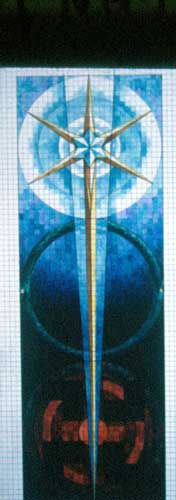|

Symbols of the Big Bang, #4, 2001-2002.
Watercolor, pastel, markers, and crayons,
40" x 30".
|
It's confusing and complicated, but maybe it wasn't always.
According to scientific theory, and to religious mythologies of many kinds, the
universe began out of one thing (not no thing, because that is impossible to
imagine) and almost instantaneously became many things, many things that are
seemingly incompatible, awkwardly proximate, like flesh and bone, circle and
square, you and me, Komar and Melamid. "The beginning of all mysteries, the mystery
of all mysteries, has hypnotized me," says Vitaly Komar in his interview with
curator Reba Wulkan for the catalogue. "When I read amateurish books and articles
about this topic, the desire to see the face of the enigma, the visual image
of the beginning of our universe and our world, intensified. The desire stemmed
from my interest to imagine, represent, and see the main hero of history, more
powerful than even Lenin or Washington. Thus, because of this desire, these canvases
and drawings, Symbols of the Big Bang, came into being."
Technically, the beginning here is a blank canvas or a blank
piece of paper, but that is misleading since the canvas or paper itself is rectangular
and therefore already a defined structure. So the beginning, or the pre-beginning
(the art beginning), as mathematics would be for scientific formulations, is
a grid for the drawings (of which there are hundreds, including about 60 in the
show), and various underlying geometries for the larger paintings (there are
four in the show). Most of the drawings and all the paintings are vertical rectangles,
like a building or a person, in which the feet are quite distant from, though
ultimately connected to, the head. In many of the drawings, however, the imagery
is contained in a square in the upper half of the rectangle, elevated on the
field of the grid and revealed as though on a scroll that had dropped down. Within
these squares is a possibly infinite (but really finite) series of smaller squares,
rectangles, triangles, and circles coalesced into six-pointed stars (Stars of
David) that in turn encompass or are interlocked with other powerful ancient
images--swastikas, serpents swallowing their tails (Ouroboroses), hourglasses,
ying-yang--all embodying doubt as well as certainty, division as well as unity
and continuity.
|


